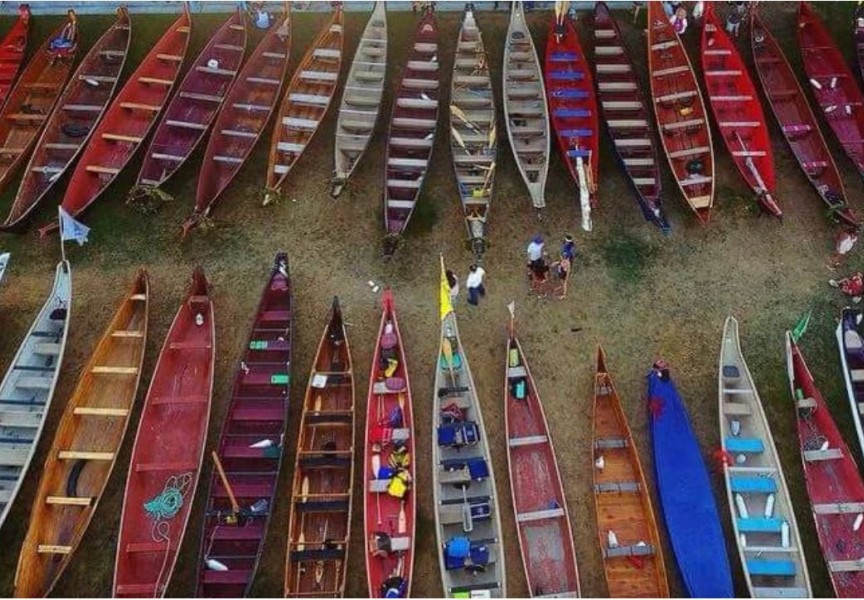Does Huu-ay-aht First Nation need the consent of Tseshaht First Nation to proceed on the $30-billion Steelhead LNG project proposed for Sarita Bay?
It’s an interesting question; one of many that Tseshaht members put to Huu-ay-aht representatives last night at a community information session held in the great room of the Tseshaht administration building.
Chief Councillor Jeff Cook was joined by Councillor John Jack, Huu-ay-aht executive director James Edwards, and communications coordinator Heather Thomson at the Tseshaht band meeting May 11 to fill the members in on the liquefied natural gas plan.
The project would receive natural gas, extracted from Northern B.C. and Alberta, at the plant site built on about 330 hectares of Huu-ay-aht-owned land at the southern end of the Alberni Inlet. The gas would be converted to liquefied natural gas (LNG) and then shipped to foreign markets in China, India, Korea and Japan.
What was expected to be a brief initial meeting stretched to almost two hours as participants peppered the Huu-ay-ahts with question after question. At the heart of the queries were common concerns.
How would this major industrial development, which would bring an expected seven massive LNG carriers a week (between 2022 to 2062) into waters on the west coast, impact the valuable salmon resource and the sensitive habitat of birds, whales and other wildlife in the territory.
And what if the worst occurs; a marine disaster that could compromise it all.
This meeting was not to be considered part of the big “C” consultation that may be required once a project description is hammered out by Steelhead and Huu-ay-aht. That point was made very clear by a number of Tseshaht members, who also wondered why it had taken so long for their friends and neighbors to sit down with them and share information about their proposal. It was May 2, 2014, after all, when Steelhead LNG and Huu-ay-aht First Nations signed their Opportunity Development Agreement. Said Tseshaht member Anne Robinson, “We are strong believers in free, prior and informed consent.”
These still are early days, with much to accomplish before a decision to proceed on the project can even be made, said Jack. It wasn’t until Nov. 29, 2014 that the Huu-ay-aht people voted 62 per cent in favor of exploring the proposed project. It is in a current phase of environmental assessments and studies. And the Huu-ay-ahts are prepared to say ‘no’ to the project if these studies produce any concerns that the proponent has labelled “show-stoppers” or that contradict the principles set out in the Steelhead/Huu-ay-aht partnership, he continued.
Huu-ay-aht said consultation was years away, but in the meantime they wanted to provide as much information as they could.
“We want you to be sick of us providing information,” said Jack.
Cook said the LNG opportunity came to Huu-ay-aht through the nation’s involvement with the Port Alberni Port Authority on the trans-shipment hub project. Steelhead was looking to partner with a First Nation and Huu-ay-aht answered the call.
The goal of pursuing opportunities like the LNG, said Cook, is to lift the Huu-ay-aht people up from the bottom tier of society.
Jack described Steelhead as a “recent” company, but with an executive team with more than 180 years of collective experience in LNG, mostly through Shell. They aspire to run an environmentally safe project that meets or beats current safety standards, he said.
At first Huu-ay-aht and Steelhead were speaking different languages, said Jack. Steelhead was coming to the project from a strictly business perspective, and Huu-ay-aht from the Nuu-chah-nulth perspective. But they created their core principles of working together: Respect (iisaak), all is one (hishuk tsawak), and taking care of (uu-a-thluk).
The LNG plant will be located 10 km northeast of Bamfield and 80 km southeast of Port Alberni. Currently, sensors are being placed around the site area to monitor a range of conditions to determine an environmental baseline.
If pursued, the construction phase of the project is anticipated to begin in 2018 and will take four years. At its peak, employment could be as high as 4,000 jobs. During operation of the plant, from 2022 to 2062, it is anticipated there will be between 300 and 400 people employed, with additional local spin-offs supporting that employment through secondary industry. There could be improvements to roads and other infrastructure.
During the question period after the presentation, Tseshaht councillor Les Sam called the Huu-ay-ahts courageous for tackling such a large project. Nuu-chah-nulth youth are moving out of the province to find work, he said. With this project comes the opportunity to stay closer to home.
Tom Watts said he was glad that the Huu-ay-ahts were creating something for the future for everyone.
Dave Watts asked about the pipeline route, but there was nothing that could be firmly reported except that the pipeline to bring the gas to the island will hook into existing and new pipeline running from northern B.C. and Alberta to about Hope.
Concern for the fragile environment of the Alberni Inlet was voiced, as well as for the environment along the entire route and at every stage of the pipeline.
Jack said they didn’t have a complete picture yet to answer those kinds of questions, and that’s what the environmental studies hope to determine. Huu-ay-ahts, he said, want to do the project correctly because they weren’t a faceless company, but Nuu-chah-nulth. They want to look at the project from every angle.
He said the project may, in fact, produce a net benefit to the environment, with monies taken off the top and put into trust for restoring the plant site at the end of the project’s life, and restoring the Sarita River, once decimated by logging.
Luke George asked about the ethics of the fracking process that extracts the gas from its source, the pollutants and the water used in that production. Councillor Eunice Joe asked if any of the money for restoration would go to the source point communities to rebuild their environment.
“We wouldn’t want to do damage in another nation’s territory,” she said.
Cook responded that they had visited communities where the fracking would occur to make sure they were in support, and they planned to work only with companies that shared Huu-ay-aht core values. Jack said Joe’s idea was an interesting one that would need to be explored with those nations.
Keith Hunter said it was awkward talking to the Huu-ay-aht representatives as friends and relatives, because they were, in fact, now “the proponent”. Tseshaht has had a lot of experience dealing with other industry proponents, including their recent experience with the Raven Coal project, and know well their practices.
He was concerned that because this is a First Nation project, there is misrepresentation flowing to media that all other surrounding First Nations will be in support. Gas is dangerous, he said.
“This isn’t my first dance.” He said the Huu-ay-ahts were coming in as friends, but were actually gathering the questions for Steelhead LNG.
Cook said the Huu-ay-ahts were talking with the Tseshahts nation to nation. The questions that Tseshaht asked, which were being recorded, were for Huu-ay-aht’s use, not for anyone else’s use.
Jack said there were thousands of questions that needed to be asked, and Tseshaht was adding to that number so that no question was left unexplored.
Darleen Watts was concerned about a marine disaster that would impact the resources that the Tseshaht people rely upon.
“If a sea disaster happens, any damage that’s done will flow to our resources.”
Jack explained the safety record of the LNG tankers that will carry the product. If gas happens to be leaked into the water it would evaporate into the atmosphere. He said the carriers themselves run on LNG, so very little other fluid could flow into the waters. He said there would be a need to have trained people at strategic locations to respond immediately to any environmental situation.
But there has been no major spill or accident with the carriers in 80,000 trips over 240 million km in 50 years, he said.
“I’m not fully sold on the idea,” said Gail Gus.
Where there is an “if” there is a possibility it could happen in our traditional waters. Do you need our support to move forward with the project, she asked.
James Edwards said he didn’t know what, or whose, consent would be required.
“We don’t even have a project description. He said when that is developed, Huu-ay-aht and Steelhead would look to see who would be affected and do the big “C” consultation then.
Keith Hunter asked that Huu-ay-aht not wait until the consultation phase to sit down with Tseshaht to develop a consultation framework with protocols.
Erma Robinson said she wanted Huu-ay-aht to remember that Tseshaht territory was not just here, in the Alberni Valley, but in the Broken Group. She worried about the birthplace of the Tseshaht people.
Anne Robinson said she also wasn’t sold on the project. “Not a little bit of it… It’s serious for us.” She said Tseshaht would guard their territory to the best of their abilities.
She said it only would take one marine disaster to destroy what they have. And it’s not just a spill they’re worried about. It could be dumping bilge water into the channel to introduce a foreign species in the territory, and there are other activities that concern the Tseshahts too.
In closing the discussion, Chief Councillor Hugh Braker thanked Huu-ay-aht for the respectful way they presented their information. He said there seemed to be some pillars the project is built upon, including the “wonders of employment” and the dollars the project will generate for the Huu-ay-aht, including other spin-offs.
But what Tseshaht is waiting to hear is that the protection of the environment would be the number one priority, he said. Last year, between Tseshaht and Hupacasath, the fishery provided $1 million to the membership and it is a huge concern that that might be threatened.
He said Tseshaht is also worried that the LNG site would light up the whole of Barclay Sound.
“We know you can see LNG plants from outer space.” How will that impact wildlife?
And Tseshaht worries about the “colossal” tankers that will come into the territory. On May 11, the carcass of a fin whale hit by a cruise ship washed into Vancouver waters at Burrard Inlet, driving home the potential dangers of tanker traffic to marine life.
Braker said he hoped the Huu-ay-ahts got a sense from the meeting about the huge interest in their project. He noted that he had followed the online discussion about the proposal, which has at times been quite heated.
Cook said Tseshaht shared many of the same comments and concerns about the project as the Huu-ay-aht citizens have voiced.
“We have to do a lot of work.”






